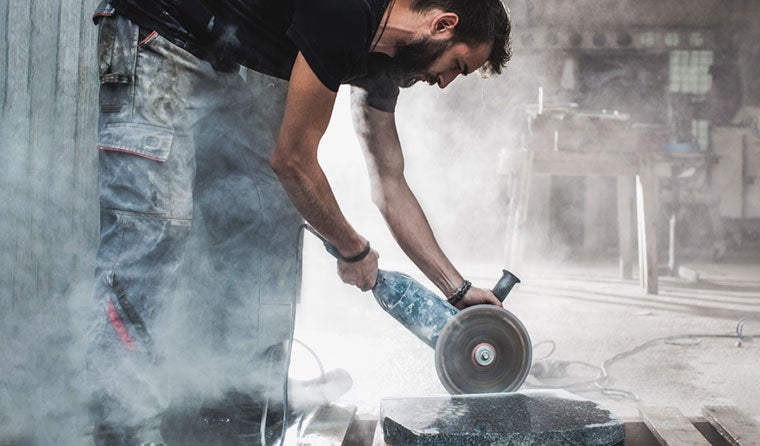
7 May 2023
Silicosis and the hidden dangers of exposure to silica dust
7 May 2023
Silicosis and the hidden dangers of exposure to silica dust

Silicosis has become increasingly diagnosed over the last five years, causing significant concern around the risks of workers occupationally exposed to silica. Silica is a common, natural substance found in types of stone, rock, sand and clay.
When exposed to very fine inhaled dust particles containing silica, the particles can become embedded in the lungs, causing permanent scarring and damage. This condition is called silicosis, which may lead to chronic lung disease and reduced lung function. There is currently no effective cure for silicosis.
The spike in diagnosed cases over recent years was initially due to the realisation that artificial (engineered) stone exposed workers were at very high risk of silicosis. It is now known that workers who have been exposed to silica in other industries are also at risk, though having generally been exposed to lower concentrations of the particles.
It is by cutting and drilling the stone that very fine, toxic dust particles are released into the air and without the appropriate safety prevention measures in place, silicosis is a very real threat to those exposed.
Engineered vs natural stone
Engineered stone is a popular, cheap alternative to marble and other natural stone used in modern kitchens and bathrooms. Compared to natural stone, it contains up to 95 percent silica compared to the 10-20 percent of traditional stone – putting engineered stone workers at much higher risk compared to silica-exposed workers in other industries.
With the higher concentration of silica in engineered stone, when exposed to silica dust, symptoms of silicosis tend to be more acute and can present many years earlier than with exposure to silica dust from natural stone.
Treatment
While there is currently no cure for silicosis, if it is detected early enough there are some treatments available to slow disease progression and improve quality of life. These include:
- Immunotherapy trials
- Some drugs
- Oxygen therapy
- Whole lung lavage, a procedure where the lungs are flushed out before silica can form scarring
- Limiting further exposure to reduce the risk of disease progression.
Who is at risk?
There are many other jobs/industries where silica dust exposure can occur, including:
- mining, quarrying and mineral ore treating processes;
- tunnelling;
- construction labouring activities;
- brick, concrete or stone cutting; especially using dry methods;
- abrasive blasting;
- foundry casting;
- excavation, earthmoving and drilling plant operations;
- clay and stone processing machine operations;
- paving and surfacing;
- angle grinding, jackhammering and chiselling of concrete or masonry;
- hydraulic fracturing of gas and oil wells, and;
- pottery making/ceramics.
Get surveillance imaging
Mandatory chest imaging is currently required for some high-risk industries in Australia (read more on this below). However, if you are concerned, it is important to speak to your GP who can arrange surveillance imaging.
Screening and detection of Silicosis at I-MED Radiology
Radiology imaging, particularly chest x-ray and CT scans, are the main tools used to screen and monitor silicosis. These tests can detect changes in the lungs that may indicate the presence of silicosis, such as nodules, scarring, or inflammation.
To ensure the most accurate diagnosis of lung disease, silicosis imaging is reported to the International Labour Organisation (ILO) standards by a National Institute for Occupational Safety and Health (NIOSH) accredited B Reader.
Only a small number of radiologists in Australia are B Reader accredited to report to ILO standards. I-MED Radiology leads the way in the screening for silicosis, with our national coverage and the largest team of dedicated chest radiologist B Readers - giving Australian workers everywhere the best possible medical imaging and detection. All High-Resolution CT chest scans for occupational lung screening are reported by our experienced subspecialty chest radiologists with recognised expertise in this field - who are also accredited B Readers.
I-MED Radiology’s B Readers can provide a result to the referring practitioner within 24-48 hours. All images are stored electronically and readily accessed online by both patients and clinicians.
Do I need an appointment?
I-MED Radiology accepts walk-ins, no appointment necessary, for chest x-rays.
High-Resolution chest CT scans are performed in most clinics. Same-day appointments are available where possible. To make an appointment you can call your local clinic directly or schedule your CT appointment online here.
Australian State Regulations
In Australia, different states have different regulations regarding dust disease screening for workers in high-risk industries. It's important to check the regulations in your state and discuss your potential risk of developing a dust-related lung disease with your doctor.
Queensland
Employees are required to undergo pre-employment and ongoing health monitoring if risk of developing a dust-related lung disease is present, particularly through the coal mining, mineral mine and quarrying industries. This includes regular chest x-rays for workers who are exposed to silica dust with CT scans indicated for some workers.
New South Wales/Victoria
Employees require health monitoring if exposed to silica dust. This includes chest x-rays and CT scans if clinically necessary.
Western Australia
Under the Western Australian Government's Occupational Safety and Health Regulations 1996, workers exposed to respirable crystalline silica must be screened for lung disease using a low-dose, high resolution computed tomography (HRCT).
